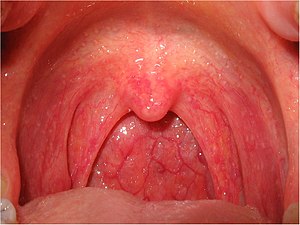 Image via Wikipedia
Image via Wikipedia
Author: Jennifer Kirkman
Step One:One of the first symptoms that have been identified with the 2009 H1N1 Flu is the onset of a fever. A fever is referred to as pyrexia by medical professionals. The average individual has a temperature of approximately 98.6F. While anything over this number may indicate the presence of a fever, most doctors agree that those over the 100.4F range have a fever that requires assistance. There are many symptoms associated with the onset of a fever considering the fact that it is regulated by a part of the brain referred to as the hypothalamus. This may include stiffness in the muscles of the body, feeling the sense of being cold, and even a heart rate that is increased as a result of constriction in the blood vessels.Step Two:The next symptoms associated with the Swine H1N1 Flu are a sore throat that may or may not be accompanied by a mild to severe cough. Individuals who contract an infection such as the Swine Flu that is viral in nature commonly experience these two symptoms. The Swine Flu is known to result in respiratory complications. If you notice either the onset of a cough or the development of tenderness in the throat, it is important to consider seeking medical testing.Step Three:If you happen to contract the Swine Flu, or the 2009 H1N1 as it is now being referred, you may suffer from gastrointestinal complications such as vomiting, bloating, and diarrhea. Many individuals who have been diagnosed have had these symptoms during the course of their condition, but then there are others that have not experienced these issues.Step Four:Aches throughout the body are a common symptom associated with this condition. You may feel aches throughout the muscles of the body as a result of fever, or you may experience a headache. Often, this soreness is a direct result of the constriction of muscles and blood vessels due to fever, but it may also be a result of the body fighting off the infection.Step Five:Many who suffer from the virus may discover that they feel extreme levels of fatigue. The body is hard at work in trying to overcome the challenges that the Swine Flu is causing it, so as a result one may feel exhausted.Step Six:Dizziness is another symptom that many who have been diagnosed with the 2009 H1N1 Virus are experiencing. This is typically indicated by a sensation that ones surroundings are spinning (vertigo) or moving. While this is also a symptom of conditions such as inner ear complications, blood pressure issues, and restrictions in the natural flow of blood through the body, it has been identified as a possible symptom of concern during the current situation involving the Swine Flu. Be certain to learn how to identify the symptoms of Swine Flu H1N1 so that you may properly protect yourself and others.
Article Source: http://www.articlesbase.com/diseases-and-conditions-articles/how-to-identify-the-symptoms-of-swine-flu-h1n1-928350.html
About the AuthorJennifer Kirkman has many websites, two of the main sites which are http://www.diabetesandrelatedhealthissues.com and also http://www.knowyourhealthmatters.com. She resides in Florida.
![Reblog this post [with Zemanta]](http://img.zemanta.com/reblog_e.png?x-id=e26b6853-7d9e-41be-bc9d-c8b651d5235e)

0 comments:
Post a Comment